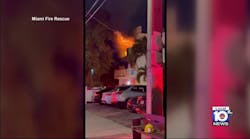Feb. 2, 1899: COLUMBUS, OH - Fire broke out in the basement of the Dunlop Building in the heart of the business district. The flames rolled across the ceiling and began to shoot up an elevator shaft. Within moments, the fire was raging throughout the structure. Several alarms were sent in quick succession, bringing the entire fire department to the scene. Across an alley to the rear of the fire building was the High Street Theater, which was packed with people watching a show. The audience was evacuated by firemen fearing the extreme exposure problem presented by the raging fire. The audience swelled the already large crowd watching the firemen struggle to stop the fire as it leaped from building to building, burning exposures on both sides. A few hours after the fire began, the front and rear walls of the Dunlop Building collapsed, sending many firemen running for their lives. As the dust settled and a roll call was taken one man was missing and feared dead. A search was started amid the flaming rubble as exhausted firemen pressed on trying to find their brother.
Feb. 2, 1899: CHICAGO - A homeless man in search of a handout was pressed into service by a woman in need of a plumber because the pipes in her house had become frozen. The woman led the man into the cellar of the house on Star Avenue in hopes she could trade a meal for the thawing of her water pipes. As she was fixing some food, she smelled smoke and went to the cellar to investigate. The man was gone and a fire was blazing - started by the candle he had been using to thaw a frozen pipe. The woman dashed from the house for help. The fire department arrived and extinguished the fire, keeping damage to a minimum.
Feb. 2, 1899: MILWAUKEE - A fire started in an express car of a mail train traveling at a high speed near Brookfield Junction. A mail-train messenger made valiant attempts to extinguish the growing body of fire while the train was still traveling. The train was finally brought to a halt and members of the crew dragged the messenger, nearly unconscious from smoke inhalation, from the car. The messenger had saved many valuable items from the freight car, but the fire was blazing out of control. The train was backed up and returned to a junction, where a water tank was used to extinguish the fire.
Feb. 3, 1899: PHILADELPHIA - At 4 A.M., a fire broke out in the W.S. Cooper establishment on Thirteenth Street and spread quickly to exposures on both sides. Arriving firemen were greatly hampered by major excavations of the street in front of the fire building and those on either side. Firemen battled bravely and with quite a bit of ingenuity to stop the flames traveling from one building to the next. The fire was brought under control after two blocks of buildings had burned. Damage was estimated at $750,000.
Feb. 12, 1899: YANKTON, SD - An alarm was transmitted for a fire in a state insane asylum building that was being used as a laundry. Due to crowded conditions in the asylum 40 women were also housed in the laundry building. Arriving firemen were faced with a severe temperature of 23 degrees below zero, little available water and an advanced fire condition within the three-story building. Twelve attendants were also in the building during the blaze and had to be saved by firemen. Seventeen of the inmates perished in the fire; the others were removed safely.
TIME CAPSULE
Feb. 12-13, 1899: Major Snowstorm Cripples Country
A severe winter storm that extended from New England to the Gulf of Mexico and as far west as Oregon blanketed the country with cold weather and dangerous amounts of snowfall. The storm would go down in history as the most destructive since the blizzard of 1888.
Twenty inches of snow fell on most areas of the Northeast. Thermometers in Kentucky recorded temperatures as low as 39 degrees below zero. Pennsylvania suffered greatly from the storm with more than 20 inches of snow on the ground, hampering travel greatly. With roads impassable, it was feared that coal supplies would run out before the weather broke, leaving many homes and businesses without heat.
Firemen across America faced snow-clogged streets, frozen water mains, hydrants hidden in banks of drifted snow, and the debilitating effects of freezing weather on men and machines. It wasn't long before firemen in numerous cities began battling blazes they would not soon forget.
A 150-foot stretch of the busiest portion of South Pearl Street in Albany, NY, was destroyed by a fire that started at 6 A.M. on Feb. 12 and was driven by strong winds from building to building. The loss was estimated at a quarter of a million dollars.
In Chicago a bitter north wind drove subzero temperatures through the city as a fire broke out in a five-story brick building on the northwest corner of Wabash Avenue and Madison Street. The structure housed the book and stationery business of A.C. McClurg & Co., which carried one of the largest stocks of rare old books and manuscripts in the nation. A gas explosion on the third floor ignited a blaze that sent flames belching out of the second, third and fourth floors before the arrival of the first fire engine. A fire building wall collapsed two hours after the start of operations, nearly landing on a number of firemen working nearby.
In New York City firemen battled a number of major fires in a rather short amount of time on Feb. 12. The first was a blaze in Nillson Hall, a catering hall that fed the well-to-do in the city for many years. The building was located on East 13th Street just behind the Academy of Music. Shortly after 7 A.M., smoke was seen coming from the upper floors and Ladder 3 arrived first within a minute of the alarm. A second alarm was quickly sent in as the fight began. Hoselines were set up to protect the Academy of Music, Tammany Hall and Pastor's Theater.
As Engine 14 pushed a line into the blazing structure Ladder 3 began to open the roof. A loud crack was heard and the engine pulled back as the roof, with six truckies riding it down, collapsed onto the top floor. The hoseline of Engine 14 covered as men from two truck companies moved in to help their dazed brothers. All men were removed from the area, and amazingly the worst injury was a broken leg. Companies were just going back into service shortly after when a fire was reported in a brass factory on East 28th Street. Four alarms were transmitted for that blaze.
A fire broke out at 9 A.M. in a loft building on Worth Street and required three alarms to control. A short time later, two alarms were needed at Central Park West and 91st Street for a fire in an apartment house. Three alarms were transmitted for a fire in a commercial building on the corner of Chambers and Greenwich streets at 12:55 P.M.
On Feb. 13, fire was discovered at 7:30 P.M. in the Silliman's Hardware building in New Canaan, CT. A fire bell sounded at the height of the storm, but could not be heard, so police and neighbors were sent out to knock on doors for help. Equipped with only a hand-drawn hose wagon and ladder truck, members of New Canaan Fire Company 1 attached their hoses directly to nearby hydrants and fought the blaze all night, creating thick walls of ice on neighboring structures. Despite the impossible weather, the firemen managed to save the town's business district from complete destruction.
On Feb. 14, major fires were again being fought. Firemen faced frozen hydrants and severe weather in a public school on Danforth Avenue in Jersey City, NJ. Firemen in Long Island City, NY, battled a blaze in a two-story wooden structure housing a barrel maker. The FDNY used three alarms for a fire in a three-story brick building on Elizabeth Street. Two alarms were needed for a brownstone building fire on West 74th Street, where the snow was so deep that rigs could not enter the block and hoses were dragged in from the avenue. Other major fires were battled in Salem, MA, and Plattsburgh and Troy, NY. Boston reportedly fought a dozen bad fires during the night. On Feb. 15, firemen battled a $1 million blaze in the Brooklyn Navy Yard.
Compiled by Paul Hashagen




